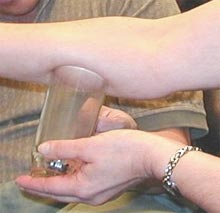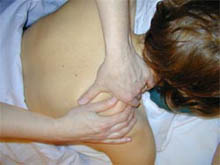|

Cupping has been a
folk treatment for thousands of years and has been called "coining" in
this country.

Therapeutic Massage
|
Once a diagnosis is
made, various treatment modalities are selected based on their harmony
with the patient's diagnosis. In Chinese herbal medicine, herbs are placed
into the same sorts of categories as the organs, using the five phases
and yin and yang. Various Chinese herbs are thought to soften fire or
reinforce yang. Herbs are chosen based on their inherent functions, based
on Traditional Chinese Medicine theory.
Acupuncture points
are selected for similar reasons. They may be on the affected meridian
or the appropriately associated meridian from a yin/yang or internal/external
point of view as discussed earlier. One also tries to select appropriate
acupuncture points that are local to the problem, regional to the problem
and that are distant from the problem. A basic tenant of Chinese medicine
and acupuncture point selection is if the upper half of the body is affected,
points are chosen on the bottom half. If the right side of the body is
affected, points on the left side are chosen. This is somewhat counterintuitive
to the Western mind.
Moxibustion is the
burning of the herb moxa on the skin, to provide local heat over acupuncture
points. Moxibustion developed as a medical practice completely separate
from acupuncture, although it is now very much a part of current acupuncture
practice in China. It is used to treat specific types of disease and is
applied over the same body points (acupuncture points) as puncture needles.
Some of the acupuncture points, such as those around the eyes, are forbidden
to moxa for safety reasons.
Massage therapy may
be selected for a variety of reasons, including general relaxation, but
also, in Chinese medicine it is believed that massage will help eliminate
pernicious influences or toxic influences.
And lastly, energy
medicine interventions, such as Chi Gong, may be selected when it is felt
that there are significant energy blockages within the major energy centers
of the body as defined in traditional Chinese medicine.
An example of a traditional Chinese case history, taken from Alternative
Medicine, the Definitive Guide, published by Future Medicine Publishing
Inc., Puyallup, WA, is as follows: "What is known as hypertension
in the West may be termed liver fire and can be treated by Traditional
Chinese Medicine (TCM). Dr. Wu, a famous physician from China, was visited
by a 42-year old man who had been diagnosed as having hypertension and
in the early stages of coronary artery disease. He complained of throbbing
temples and soreness at the top of his head. An examination identified
the following elements: red (not pink) tongue, deep yellow urine, constipation,
poor appetite, painful teeth and eyes, insomnia, pain on the right side
of the body and excessive dreaming. His pulse was 'wiry and sinking.'
The man was diagnosed with 'constrained liver chi accompanied by liver
fire, ascending to disturb the head.' The treatment called for harmonizing
the liver, cooling the fire, and transforming mucus. Twelve herbs were
given as a tea for three days and another combination for nine additional
days. With this treatment, the patient's blood pressure dropped from 180/130
to 130/90, within the normal range, and soon all his symptoms disappeared.
A final herbal prescription was then given which was taken for a longer
period of time to insure that the patient's blood pressure remained normal."
  |
|